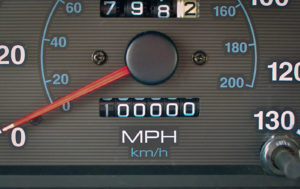What You Need to Know About Your Car’s 100k Mile Service?
July 6th, 2020 by Fix Auto USA

If your car made it to 100,000 miles, congratulations, and no, it doesn’t mean you need to buy a new car.
But this milestone also indicates that it is time to take your car in for its 100k mile service. If you’ve properly maintained your car, there is no reason it can’t last for another 100,000 miles.
What is in store for your car’s 100,000 mile maintenance?
How about a timing belt inspection? Did you know that if your timing belt is wearing down, after a while, it could break and cause severe problems for your engine?
Have a professional mechanic check your timing belt at your 100,000 mile tune up and replace it if it’s worn. It can help avoid a damaged cylinder head and a costly repair bill.
And while you’re at it, you will want to have your water pump replaced in addition to your car’s fluids like your oil, transmission fluid, brake and power steering fluid, and your coolant. We can’t overstate the importance of maintaining proper fluid levels. They play a vital role in almost every function of your car, especially when it comes to fuel efficiency and longevity.
If your car reached 100,000 miles, then it is a safe to assume that you’ve had to replace your breaks along the way. Even so, it is a good idea to have them checked during your 100,000-mile maintenance. If you have disk brakes, your rotors might need to be turned if the rotors are worn.
Next are your tires. According to the National Highway Traffic Safety Administration (NHTSA), cars with underinflated tires by more than 25 percent are three times more likely to be involved in a collision. Note that underinflated tires cause 660 highway deaths and 33,000 injuries annually.
If you’ve been meticulous about caring for your tires – checking air pressure, tread, and having them rotated a few times a year – then they may still be in good driving condition. But if not, it is probably time to have your four tires – or at least two – replaced. If you notice your car is veering to one side or the other, it could be an indication that you need a wheel alignment.
Here is a breakdown of the main parts that should be inspected as part of your car’s 100,000 mile tune up:
- Brakes, brake lines, hoses & connections
- Rotate tires and check the air pressure
- Exhaust system
- All fluid levels
- Boots, drive belts, seals and drive shaft
- Fuel lines, hoses & connections
- Steering, suspension, tie rods ends.
Steering and suspension problems not only cause steering problems, but they also accelerate the wear of your tires. Avoid these problems by ensuring your steering fluid is changed and that your shocks are inspected by a professional.
- Parking brake
- Water pump
- Spark plugs
- Air filters
In all likelihood, your transmission fluid, oil, coolant, power steering fluid, and brake fluid will all require to be replaced during your 100,000 mile maintenance appointment.
Remember, first things first: start by consulting your car’s service manual, which was prepared by the folks who designed and built your vehicle. Recommended intervals for your 100k mile service will be indicated.
Bring your car into your local auto repair shop, so a highly trained and trusted mechanic can conduct a thorough inspection.
And be sure to continue with regular car maintenance after 100 000 miles – and, who knows, your car could last very well for another 100,000 miles.
This blog post was contributed by Fix Auto Lemon Grove, a leading industry expert and collision repair shop servicing customers in Lemon Grove, CA as well as San Diego County neighborhood.
Welcome to
Fix Auto USA
We are the premier independent body shop network delivering world-class customer service and high-quality collision repairs across the U.S.
Learn About Us





